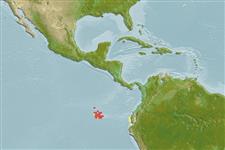>
Blenniiformes (Blennies) >
Dactyloscopidae (Sand stargazers)
Etymology: Platygillellus: Greek, platys = flat + Theodore Nicolas Gill (1837-1914) researcher of abyssal fishes and systematics (Ref. 45335).
Environment: milieu / climate zone / depth range / distribution range
Ecologia
marino demersale; distribuzione batimetrica 0 - 20 m (Ref. 28023). Tropical
Eastern Pacific: endemic to the Galapagos Islands.
Length at first maturity / Size / Peso / Age
Maturity: Lm ?, range 4 - ? cm
Max length : 6.2 cm SL maschio/sesso non determinato; (Ref. 28023)
Prefers shallow waters where the sediment size is tiny, especially intertidal areas that have white coral sand. Never found in waters that are brackish or fresh. Carnivores, which prey on a variety of benthic invertebrate animals (Ref. 28023).
Life cycle and mating behavior
Maturità | Riproduzione | Deposizione | Uova | Fecundity | Larve
Possibly viviparous with internal fertilization (Ref. 28023).
Grove, J.S. and R.J. Lavenberg, 1997. The fishes of the Galápagos Islands. Stanford University Press, Stanford, 863 p. (Ref. 28023)
IUCN Red List Status (Ref. 130435: Version 2024-2)
Threat to humans
Harmless
Human uses
Strumenti
Special reports
Download XML
Fonti Internet
Estimates based on models
Preferred temperature (Ref.
123201): 23.5 - 25.6, mean 23.8 °C (based on 20 cells).
Phylogenetic diversity index (Ref.
82804): PD
50 = 0.5156 [Uniqueness, from 0.5 = low to 2.0 = high].
Bayesian length-weight: a=0.00389 (0.00180 - 0.00842), b=3.12 (2.94 - 3.30), in cm total length, based on all LWR estimates for this body shape (Ref.
93245).
Trophic level (Ref.
69278): 3.5 ±0.37 se; based on food items.
Resilienza (Ref.
120179): Medio, tempo minimo di raddoppiamento della popolazione 1.4 - 4.4 anni (Fec = 316).
Fishing Vulnerability (Ref.
59153): Low vulnerability (10 of 100).
